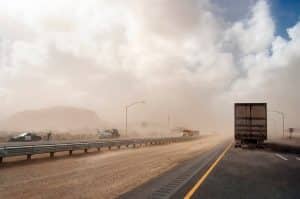Multi-Vehicle Crash on I-55 Shows Just How Deadly Dust Storms Can Be
 The dust storm that blew through Illinois yesterday covered 20-30 miles and caused a 72-vehicle pileup on I-55. At least six people have died and 30 more were injured in chain reaction crash.
The dust storm that blew through Illinois yesterday covered 20-30 miles and caused a 72-vehicle pileup on I-55. At least six people have died and 30 more were injured in chain reaction crash.
ABC 7 News reports that there is a risk of HAZMAT spills (two semi-trucks caught fire). One Chicago resident told the news that the aftermath on I-55 “felt like a war zone. We could see bodies that were just lifeless laying in the grass on the side of the road."
A dust storm is defined as “a wall of dust and debris that is blown into an area by strong winds from thunderstorms. The wall of dust created by a dust storm can be miles long and several thousand feet high.” They’re really common in the Southwest, but they can happen anywhere; a massive one made it to the Dakotas last year.
So should we be worried about dust storms?
The answer is “maybe.” Dust storms are caused by “dry, loose dirt coupled with strong winds are what cause these dust storms… [and] we are experiencing these dry conditions and strong winds in central Illinois,” per Darren Leeds, a meteorologist with Fox Illinois. He elaborates:
It's actually pulling all that dust in, and can often pull some sand out of some of that soil as well. And so, essentially, what it's doing is kicking that up into the atmosphere, you get that big wall of dust. I would kind of compare this to what we see with a strong winter storm or some blizzard conditions, very strong winds that white-out conditions happening with those winter storms. And this is pretty much the same thing, but just with some dust, some dirt in the air as well.
Since it’s planting season here, and tilling loosens topsoil, it’s entirely possible that we could experience another storm.
What should I do if I get caught in a dust storm while driving?
PULL OVER. If you’re out on a highway like I-55 (or any road, really) and you see the dust blowing, pull over to the side of the road and put your car in park with the e-brake on. Turn your hazards on to increase your visibility. As Leeds explained, dust storms create white-out conditions; it is incredibly difficult, if not impossible, to see while the storm blows over you. You should treat a dust storm like you would any storm where precipitation is coming down so hard and fast that your wipers can’t keep up. The difference here is that even if your wipers work, they won’t clear the air around you.
Staying put with your lights on is your safest bet. But we know that may not be possible. The National Weather Service offers this advice if you cannot stop safely:
- Don't enter the dust storm area if you can avoid it.
- If you can't pull off the roadway, proceed at a speed suitable for visibility, turn on lights and sound horn occasionally. Use the painted center line to help guide you. Look for a safe place to pull off the roadway.
- Never stop on the traveled portion of the roadway.
What happens if I get into a car accident during a dust storm?
If you can’t avoid or get out of the storm and you are hit by another vehicle, don’t panic. (We know that doesn’t sound helpful, but it’s still good advice.) Do not exit the car. If other drivers couldn’t see your lights, they almost certainly can’t see you. So, unless the car is on fire, stay in your vehicle. If there’s enough visibility (and your car isn’t smashed up) to pull over a bit, try to do so.
Then, call 9-1-1. Understand that it may take some time for emergency services to reach you because they can’t see into the storm, either. But you want to make sure they are alerted to what happened so they administer care as soon as they possibly can.
Finally, you should set off some road flares. Since it’s unsafe to exit the vehicle, your best bet is to carry LED flares with you as well as traditional flares. The LED lights will offer some visibility in the storm which could help other drivers see you AND help EMS find you. Do not set fire to a road flare in your car.
Can you file a car accident claim for a dust storm?
Yes, you can file a car accident claim if you get hurt in a dust storm. Will it be easy without the help of an experienced Chicago car accident lawyer? It will not.
The thing is, you can’t sue a weather event. And you can’t sue someone who you think caused a weather event. That means you’d need to file a claim against the driver(s) who hit you – and those drivers are probably going to file claims against the drivers who hit them, and so on and so forth. There were 72 vehicles in that pileup yesterday: that’s 72 different policyholders whose insurance companies are all going to be pointing the finger at one another (and potentially themselves, given the chances that multiple drivers will be insured by the same companies).
So what we have to do is show that the driver who hit you (or who hit someone else who then hit you) was behaving unreasonably. Did the at-fault driver plow into you without trying to stop, even though your lights were on? Did that driver stop dead in the middle of the road and not leave their hazards lights on? Did that driver try to travel on the shoulder at the same speed to get past the rest of the vehicles? Did that driver do something else dangerous or reckless that put people in danger? Did a trucking company force their driver to keep moving even though the trucker had no visibility? Did a vehicle’s brakes give out because of a defect?
There’s a lot to unpack in any multi-vehicle claim, and ones resulting from weather events can be a challenge. But when you have an attorney on your side, you may end up getting a settlement offer that’s fairer from the start – especially when the insurance company knows your attorney is willing to go to trial if that’s what’s best for you.
Gainsberg Injury and Accident Lawyers represents injury victims in Chicago and all the surrounding areas. No matter who caused the crash that led to your injuries, we are ready to help. Give us a call or fill out our contact form to schedule your free consultation.

Attorney Neal Gainsberg has spent the last 20+ years fighting to protect the rights of the injured in Chicago and throughout Illinois. For dedicated legal help with a personal injury, car accident, or wrongful death matter, contact Gainsberg Injury and Accident Lawyers in Chicago for a free consultation.
